Ischemic vs. Hemorrhagic Stroke Symptoms
A stroke is a life-altering experience. The subsequent emotional, mental, and physical changes often introduce new challenges for survivors and their loved ones as they navigate a new life. We should all have empathy and compassion for anyone who has gone through this.
Understanding the two types of strokes and how they impact each individual is essential. An ischemic stroke happens when the blood supply to the brain gets interrupted. A broken blood vessel that allows bleeding to occur in the brain causes a hemorrhagic stroke. In either situation, seek medical treatment immediately.
Here’s more about ischemic vs. hemorrhagic stroke symptoms and the steps to take if a stroke impacts you or someone you love.

The Key Differences Between Ischemic vs. Hemorrhagic Stroke Symptoms
The brain is a powerful yet delicate organ that enables the body to participate in countless activities. But when this organ experiences a stroke, it can manifest in several ways. These manifestations can, unfortunately, make even routine activities we took for granted much more difficult.
Both ischemic and hemorrhagic strokes minimize blood flow to the brain. Some of the symptoms of both types include:
- Sudden weakness or numbness on one side of the body
- Confusion
- Headaches
- Seizures
It’s important to know that frequency and symptom type can vary when comparing ischemic and hemorrhagic strokes. For example, seizures are more common in hemorrhagic stroke patients, while nausea and vomiting occur more often with ischemic strokes. Both ischemic and hemorrhagic strokes may involve headaches, but those experiencing hemorrhagic strokes are more likely to have sudden, severe pain in the back of the head.
No matter what symptoms you or a loved one face, it’s critical to seek medical attention immediately if any of these signs are present.
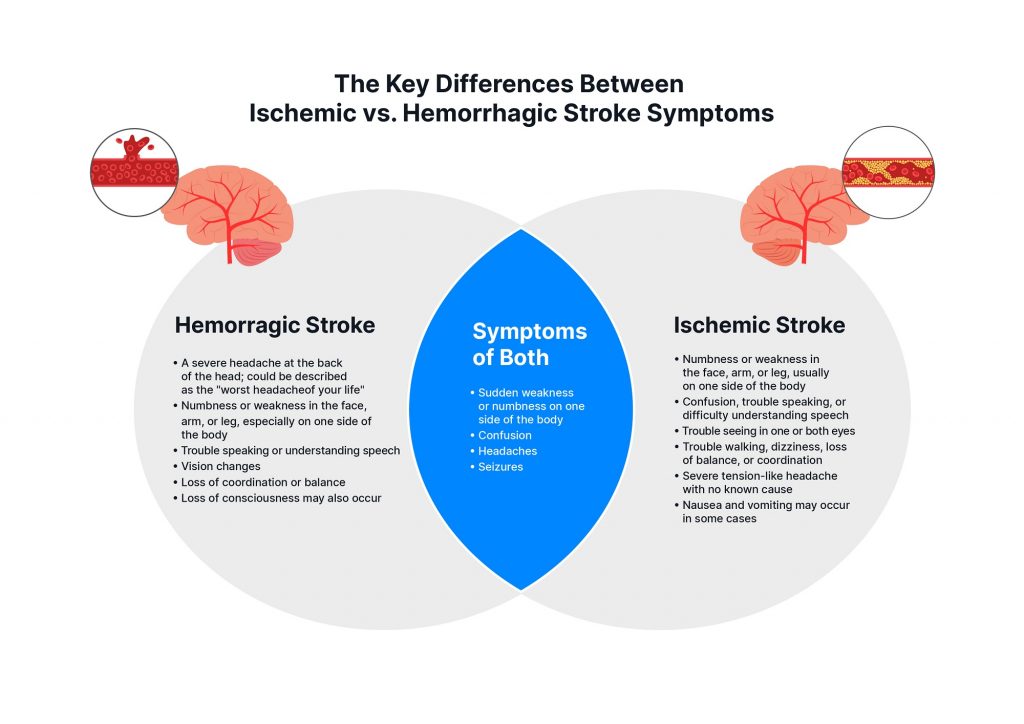
Understanding Ischemic Stroke
Ischemic stroke happens in response to a blockage of the blood supply to the brain. This blockage prevents brain tissue from getting the necessary oxygen and nutrients.
Ischemic strokes “account for about 87% of all strokes.” The two types of ischemic strokes are:
- Thrombotic stroke: Caused by a blood clot that builds in an artery that supplies blood to the brain
- Embolic stroke: Caused by a clot that forms in the body and travels through the blood vessels to the brain
Common Symptoms
The severity of ischemic stroke symptoms can differ depending on the location and impact of the stroke. These can include sudden:
- Numbness or weakness in the face, arm, or leg, usually on one side of the body
- Confusion, trouble speaking, or difficulty understanding speech
- Trouble seeing in one or both eyes
- Trouble walking, dizziness, loss of balance, or coordination
- Severe tension-like headache with no known cause
Additional symptoms, such as nausea and vomiting, may occur in some cases.
Understanding Hemorrhagic Stroke
Hemorrhagic strokes happen due to weak blood vessels that rupture and bleed into the brain. This stroke category is further split into two sub-categories:
- Intracerebral hemorrhage: Bleeding into the brain tissue
- Subarachnoid hemorrhage: Bleeding in the space that surrounds the brain
Common Symptoms
Common symptoms of hemorrhagic stroke involve a sudden onset of:
- A severe headache at the back of the head; could be described as the “worst headache of your life”
- Numbness or weakness in the face, arm, or leg, especially on one side of the body
- Trouble speaking or understanding speech
- Vision changes
- Loss of coordination or balance
- Seizures and loss of consciousness may also occur.
Again, we strongly urge you to seek medical attention if you or someone you know experiences any of the symptoms of an ischemic or hemorrhagic stroke.
You can also learn about the 5 things you can do to help a stroke victim recover – or Ways to Enhance Your Post-Stroke Journey: 3 Brain Exercises to Consider.
It’s Never Too Late to Seek Help for Stroke Recovery

Recovery after a stroke is a unique journey for each survivor, and timelines can vary greatly—it’s common and understandable to feel discouraged along the way. Stroke recovery is not always linear and can involve ups and downs. But If it’s been months or even years after the stroke incident and your progress still isn’t where you want to be, you can still have hope.
Backed by a diverse medical staff and over a decade of leading research, the Aviv Clinics team is here to help you be empowered. Our post-stroke program has revitalized individuals’ cognitive and physical capabilities, even years after a stroke.
Contact us today to learn if the Aviv Clinics stroke recovery program is right for you or your loved one.
Watch Cindy’s Remarkable Recovery Story
Ways to Enhance Your Post-Stroke Journey: 3 Brain Exercises to Consider
When we think of exercises, we often think about movement. As much as physical activity is essential to post-stroke health, mental exercises are just as important.
For post-stroke patients, brain exercises can be a critical component of their rehabilitation journey, as “cognitive impairment and memory loss are common after a stroke.”
The good news is the brain is a powerful organ that can learn at any age. Medical experts note, “the reality is that everyone has the capacity to develop new cells that can help enhance cognitive functions.” The more you will engage your brain – the better are the chances you will see cognitive improvement.
Brain exercises can unlock this potential. Below, we offer insights into three main types of brain exercises for stroke relief: games, apps, and lifestyle activities. We also discuss the training Aviv Clinic’s post-stroke program can offer, so don’t miss out.
1. Games for Stroke Patients
Games are not only fun, but they can also improve cognitive performance.
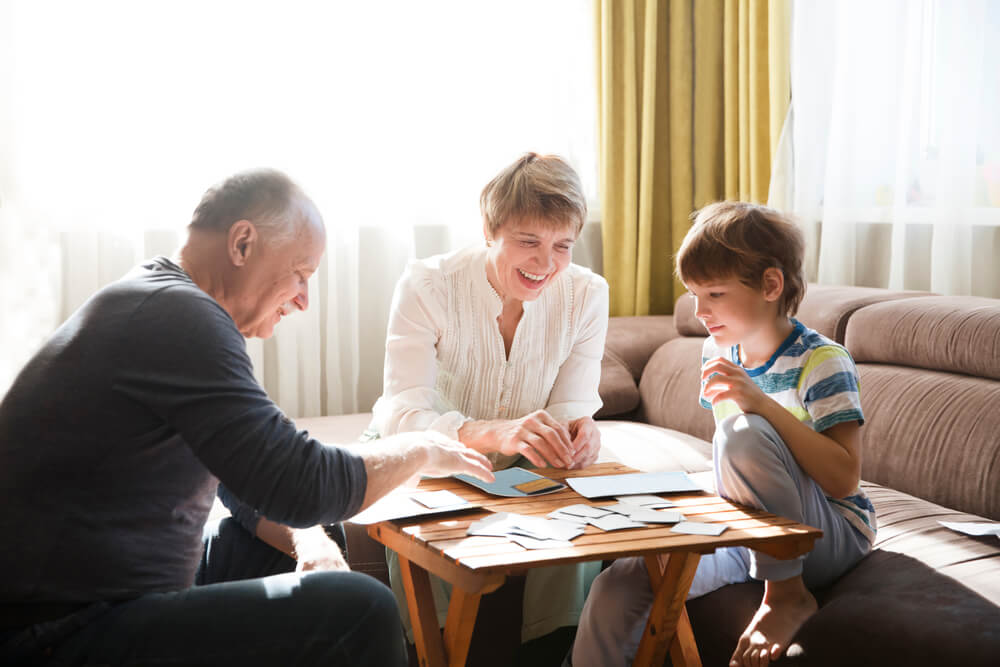
Puzzles
Games like crossword puzzles, Sudoku, and word searches are excellent activities to stimulate the brain.
The most impactful? Crossword puzzles. Researchers specify crossword puzzles are “superior to other brain games in improving memory.”
Let’s also not forget the accessibility crossword puzzles offer—you can find them anywhere online or in newspapers and easily take them on the go.
Board Games
Board games often require critical thinking and teamwork.
Playing board games—like Scrabble, Connect Four, and Battleship—stimulates brain areas that oversee memory formation and thought processes. Games do this by:
- Encouraging high-level thinking. Board games can improve brain skills like strategic thinking, logic, attention, memory, and comparison. Researchers report that “playing non-digital games may be a positive behavior in terms of reducing cognitive decline.”
- Enhancing creativity and self-confidence. The collective nature of board games can help post-stroke patients with creative problem solving while connecting with their friends and family.
Video Games
In a study where post-stroke patients participated in playing Wii Sports Resort—a collection of sports simulation mini-games:
- The group who played video games “achieved better results than the control group”
- Among attention, processing speed, and working memory, “the attention and processing speed improved” the most.
These results illustrate the potential video games have in supporting cognitive rehabilitation after a stroke. Like board games and puzzles, video games can offer the same stimulation the brain needs to enhance critical thinking and memory.
One study even notes that motor-sensor video games could offer physical benefits. When working with a therapist, the games “allow patients recovering from a stroke to improve their motor skills and affected arm movements.”
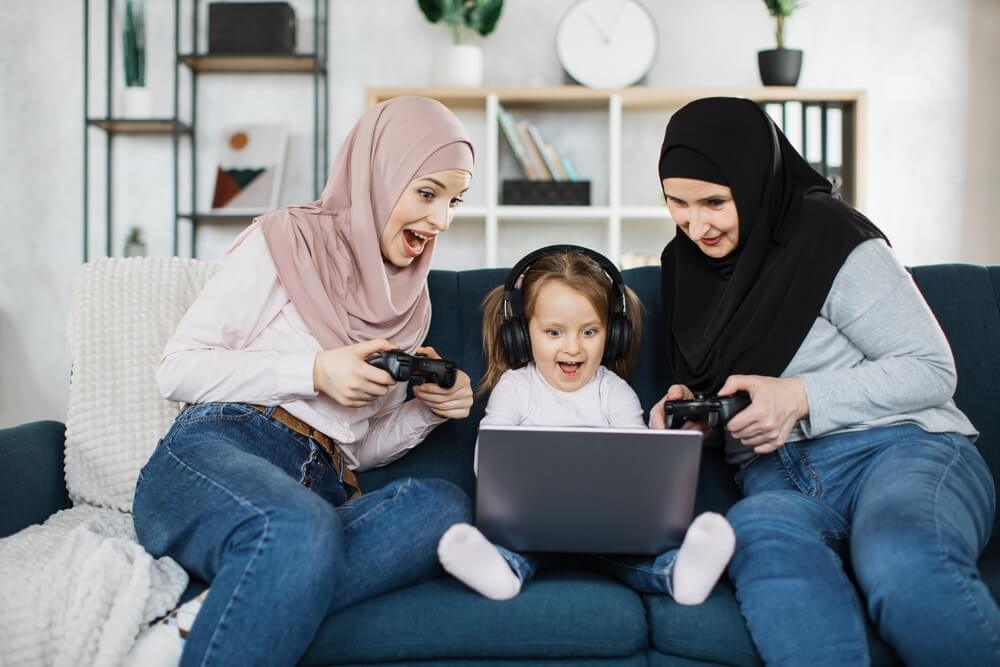
2. Devices and Apps for Stroke Patients
There are some specific devices and apps that provide access to speech and cognitive activities. Though most apps are not specifically for stroke patients, they can still help with neurological rehabilitation.
One tip is to look for ‘Psychomotor skills” apps that calibrate themselves to an individual’s motion range. These can be especially useful for stroke patients.
Here are examples of helpful devices and apps for stroke patients:
- BrainHQ is a cognitive training app. The app offers several games that help Aviv Clinics’ clients improve skills in areas—such as memory, attention, brain speed, and navigation—that stroke survivors may struggle with. You can even design your own program, choosing exercises and workouts that meet your personal interests.
- MindMaze has a helpful game-based digital therapy called MindMotion™ GO. It offers full-body motion capture, allowing patients to practice physical and cognitive exercises at the same time.
- Lumosity offers exercises for your mind with a fresh set of games daily to keep your brain consistently challenged. The app also provides reports that track your progress.
- VAST is a virtual reality rehabilitation system we use at Aviv Clinics. It offers the flexibility to work in any physiotherapy practice and helps our patients engage in moto-cognitive activities.
3. Lifestyle Activities for Stroke Patients
Here are some lifestyle activities for stroke patients that shake things up by offering more diverse, non-digital options that can create balance in your life.
Music
Listening to music offers an emotive experience that enhances mood and improves memory. Frequently, a specific song elicits certain memories or forms new ones.
Studies note that music therapy can be a good “motor function rehabilitation” method. Listening to music or singing songs can help “promote neural plasticity”—the ability of the nervous system to adjust itself—and improve “patients’ motor function.”
Have you been interested in learning to play a musical instrument? This activity may offer additional benefits, as “Listening to and performing music reactivates areas of the brain associated with memory, reasoning, speech, emotion, and reward.”
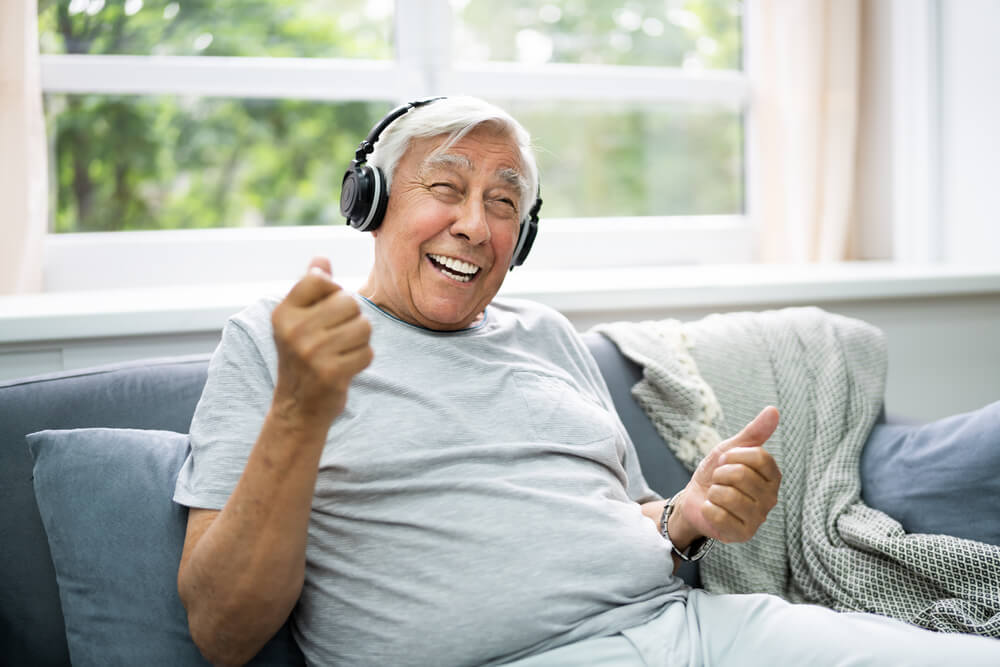
Photography
The Stroke Association recommends photography as a leisure activity. Take a walk around a nearby park or nature sanctuary and take some photos. Photography can be a therapeutic activity that offers a healthy and peaceful distraction. You’ll also get a chance to move your body while snapping pictures.
Aviv Clinics: Post-Stroke Program
The Aviv Medical Program offers a comprehensive post-stroke program targeted to those in the chronic post-stroke phase, typically six or more months after the incident. The Aviv Medical Program consists of a plan that can include the following:
- Hyperbaric oxygen therapy (HBOT)
- Cognitive training
- Physical training
- Dietary coaching
- In-depth review of health history
- Comprehensive physical exam
- Highly advanced brain imaging scans
- Neurological and neurocognitive tests
- Body composition analysis
- A detailed report of our assessment findings
- A post-program report of your improvements and recommendations for future progress
All components of this plan are included in a physician-designed program tailored to the needs and goals of each patient.
Cognitive Training Program
The cognitive training portion of the Aviv Medical Program is performed both inside and outside our hyperbaric oxygen suites. During HBOT sessions, your brain and body unlock their regenerative mechanisms. This helps you become more receptive to other forms of therapy.
As part of your treatment, you may also complete our unique cognitive training regime while exerting yourself physically on the cutting-edge h/p/cosmos medical treadmill. Research shows this combination of physical and cognitive effort maximizes the benefits of the Aviv Medical Program, taking your brain and body to the next level.
Find Hope with Aviv Clinics
Life after a stroke can be challenging. A stroke can suddenly strip away the capabilities we take for granted. Support, trust, and consistency are vital to getting back to optimal health. The medical team at Aviv Clinics offers all three elements while crafting a personalized rehabilitation plan specifically for you.
If you’ve tried the suggested brain exercises for stroke relief and other therapies but haven’t received the desired results, it’s time to seek the help of Aviv Clinics.
Hyperbaric Oxygen Therapy (HBOT) Options for Stroke Recovery
Stroke Recovery
Stroke prevalence has spurred scientists to develop more effective stroke recovery therapies, including hyperbaric oxygen therapy (HBOT).
Recovery from an ischemic or TIA (“mini stroke”) may not be guaranteed, but this much is clear: people who receive timely and effective treatment recover with fewer post-stroke effects.
Unfortunately, timely treatment is not always attainable:
- Stroke is a “leading cause of death in the United States and is a major cause of serious disability for adults.”
- “More than half of stroke survivors age 65 and older” experience reduced mobility, relegating some individuals to a wheelchair for the remainder of their lives. Many struggle with cognitive function, speech difficulties, and visual impairments as well.
Thankfully, advanced rehabilitation programs exist, including hyperbaric oxygen therapy (HBOT) options and other therapies. The experts at Aviv Clinics discuss these key details below.
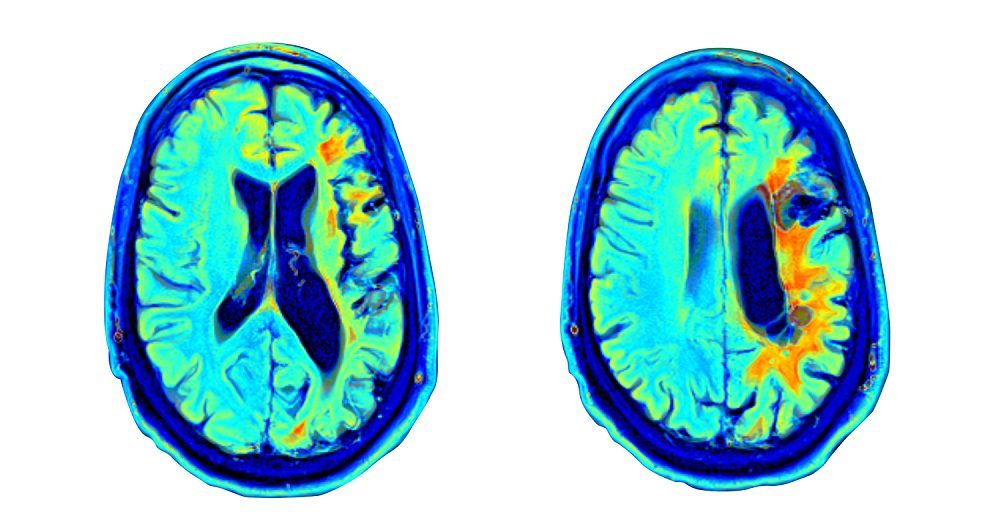
What Happens to the Brain during a Stroke?
When a stroke strikes, it immediately starts killing brain cells due to loss of blood flow. As many as two million brain cells die each minute the stroke goes untreated. Other cells become injured but don’t necessarily die off. Neurologists often describe them as being “stunned”.
Still, a significant part of the brain’s real estate comes under attack. The combined damage from injured and necrotic (dead) brain cells results in both immediate and long-term symptoms such as:
- Limb weakness or paralysis
- Slurred speech
- Vision complications
- Balance issues.
Nothing can be done about the dead brain cells, which is why timely intervention is so critical. However, a growing body of research indicates that HBOT can help repair the injured cells, even years after the initial stroke
What Is Hyperbaric Oxygen Therapy (HBOT)?
Hyperbaric oxygen therapy (HBOT) is a type of therapy that uses pressurized chambers to allow individuals to breathe in 100% pure oxygen.
In the hyperbaric suites at Aviv Clinics, the air is pressurized in the HBOT chamber to above atmospheric levels. This environment increases oxygen levels in the body to about 17 times higher than normal, allowing oxygen to be delivered even to damaged cells, such as those injured by stroke.
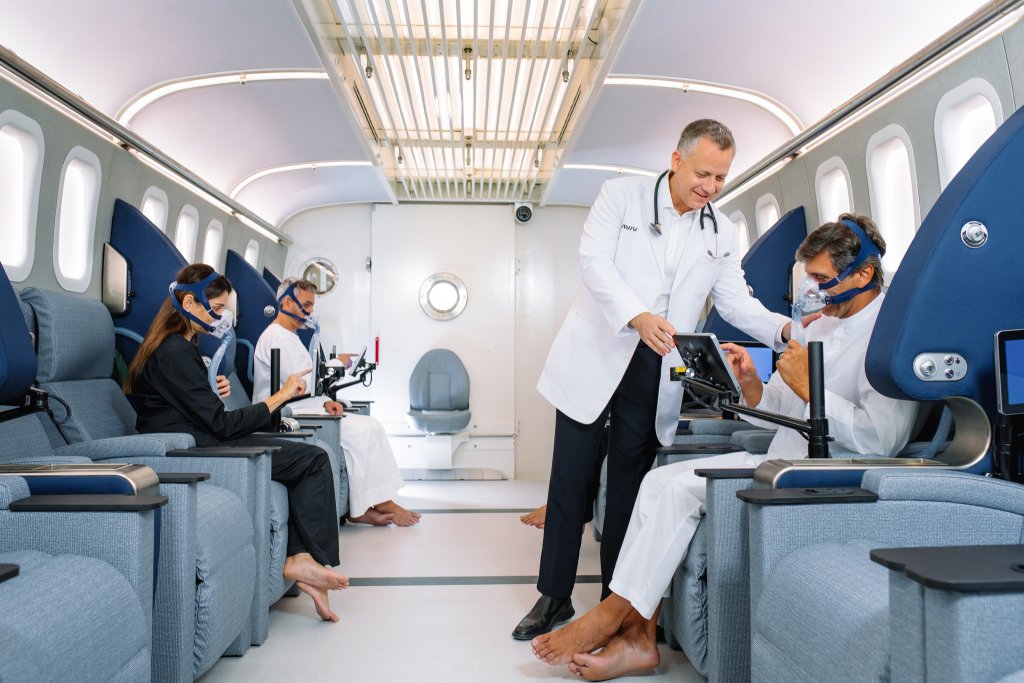
How Does HBOT Help with the Post-Stroke Recovery Process?
The unique HBOT protocol at Aviv Clinics uses a scientifically validated process in which oxygen levels are fluctuated throughout the HBOT session. When the mask is on, oxygen levels are very high. But, when the mask is off, the body is deceived into sensing a state of “low” oxygen because of the rapid decline.
This fluctuation triggers the body into repair and regeneration mode, which in turn:
- Stimulates stem cell proliferation
- Improves injured cell health
- Builds new blood vessels, optimizing blood flow
- Grows new connections in the brain
In the past, growing those new connections was inconceivable. Scientists previously believed that once neurons were destroyed, they could never rebound. Research has since disproved that notion.
What Benefits Can Stroke Survivors Achieve with HBOT?
Several studies have proven the benefits of using HBOT in post-stroke recovery. Repair mechanisms in the brain, prompted by HBOT, result in:
- Regained speech and reading capabilities
- Restored motor function, even with paresis
- Return to independence in performing daily activities
The Aviv Medical Program
When combined with the exercise, personalized nutrition, and extensive assessments that are part of the Aviv Medical Program, the outcomes become even more impressive:
- Some Aviv clients progress from using wheelchairs to walking on their own or with an assistive device.
- Clients who lost their ability to speak make immense recovery strides.
- Many report that the biggest benefit is simply not being a “burden” on their loved ones.
Our post-stroke program remains focused on research and incorporates a holistic and personalized approach that can include the following:
- In-depth review of health history
- Comprehensive physical exam
- Highly advanced brain imaging scans
- Neurological and neurocognitive tests
- Body composition analysis
- A detailed report of our assessment findings
- Cognitive training
- Physical training
- Dietary coaching
- Hyperbaric oxygen therapy (HBOT)
- A post-treatment report of your improvements and recommendations for future progress
Learn more about the program>>
Even if a person has no visible effects after having a stroke, the brain has still been damaged—and they are at a higher risk for a subsequent stroke. HBOT, through the Aviv Medical Program, can help mitigate that risk by improving the flow of blood to brain tissue and potentially prevent future strokes from occurring.
How Soon after a Stroke Can Hyperbaric Oxygen Therapy Be Administered?
Aviv Clinics recommends a 3-6 month wait after a stroke before beginning the Aviv Medical Program protocols. This allows for the brain’s natural healing progression to take hold.
The sooner stroke survivors act after the post-acute stage, the better. The research our scientists have done indicates a strong cohort from the one-month point to four years post-stroke.
That said, there’s really no limit on how long after a stroke individuals can participate in the program. We’ve seen success in clients who were as many as 10 years into their stroke recovery.
How Long Does It Take to See Results?
Most people see improvement from the Aviv Medical Program within the 8-12 weeks of therapy and medically verifiable results by the end of their treatment.
But keep in mind, no one-size-fits-all approach exists. You’ll receive your own unique therapy plan, so outcomes and timelines vary. Our ability to quantify your health plan is ultimately what delivers results.
For reference, here is a general overview of what our program looks like:
- Step 1: Assessment—A comprehensive set of neurocognitive, physical, and genomic assessments.
- Step 2: Treatment—Based on the assessment, we develop a customized routine that can include hyperbaric oxygen sessions with other types of personalized training/therapies. These may take place over 12 weeks.
- Step 3: Analysis—Our team uses advanced analytics to assess your program’s efficacy, and make the necessary adjustments.
- Step 4: Follow up—The Aviv Clinics team will offer ongoing monitoring and engagement post-treatment to help maintain your results.
Keren Trabelsi Finds Hope after Her Stroke
“[Treatment at Aviv is] like driving a Ferrari on the road to recovery versus driving like an old beaten-up car….”
Former Aviv Clinics client Keren underwent an ischemic stroke. This caused cognitive issues and paralysis on the left side of her body. Daily tasks grew more difficult, which left her feeling defeated.
Fortunately, Keren found the Aviv Medical Program. Aviv Clinics provided a personalized treatment plan encompassing many of the therapies we outlined earlier.
Thirteen months later, Keren can walk comfortably, type with her left hand again, and engage in a myriad of activities (crossword puzzles, Sudoku, etc.) she couldn’t participate in after her stroke.
The Bottom Line
Stroke survivors no longer need to feel like life is over due to debilitating cognitive and physical impairments. The Aviv Medical Program is rooted in extensive scientific research and has been instrumental in helping stroke survivors thrive well into their golden years.
Contact us to learn more about the Aviv Medical Program and how it can benefit you or a loved one.